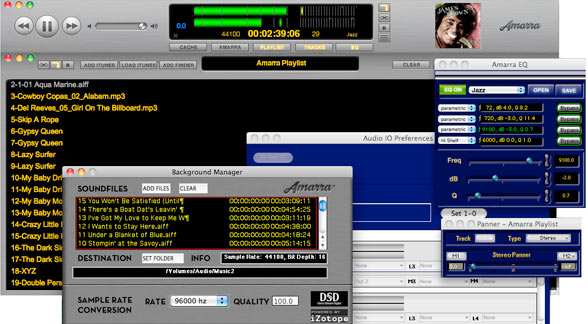Red and Blue DSD
The Newport Audio Show was in full swing yesterday, at least at the Hilton Hotel where traffic “swamped” a friend’s vinyl sales area in the marketplace. There were a whole lot less people willing to walk through the 90 degree sunshine over to the adjacent Atrium Hotel to visit the vendors doing business there. AIX Records is set up on the patio outside the headphone room at the Atrium and all I can say is there was plenty of time to answers questions and visit with other vendors nearby. This show desperately needs to consolidate under one roof. I had been warned that the secondary hotel was a wasteland but was told by the show’s organizers that there would be plenty of visitors coming by. Saturday is usually the biggest day at a show like this…it didn’t happen.
Fortunately, one of the other booths on the patio was Sonic Studios. My long time friends Jonathan Reichbach and Rolf Hartley were there showing off their Amarra playback software. In the emerging world of “computer audio”, Amarra is THE standout high-end audio playback engine. It embraces the user interface and library management capabilities of Apple’s iTunes application but routes the audio (standard and high definition) through the Amarra code, which is the same processing engine that I’ve used to master commercial CDs and DVDs for over 20 years. This is the real deal in properly handling PCM bitstreams.
In 1989, I started the Pacific Coast Sound Works in the garage of my house in the San Fernando Valley. I purchased a Sonic Solutions CD Premastering System and all of the required peripheral equipment for $44,100 (interesting reference to the sample rate of the CD Redbook specification) and went into business editing and assembling CDs. Their main software guru was Andy Moorer, one the most experienced and smartest DSP engineers on the planet (he’s now a professor at UC Berkeley). Jonathan Reichbach was one of the team of software engineers working with Andy in their Northern California offices. When Sonic moved away from audio workstations and into DVD and Blu-ray authoring, Jonathan purchased the professional audio assets and started Sonic Studio. I would guess that virtually 80% of all CD releases are mastered using the Sonic System.
I got talking to Jonathan yesterday about what he thinks of DSD and the recent push by various parties and publications to resurrect the format that Sony/Phillips abandoned 6 years ago. I wanted to know his thoughts about DSD from a software or programmers point of view just as I wanted to know about the hardware side from John Siau, the design engineer at Benchmark (see the interview with John). I was not surprised by his responses.
Jonathan is not a fan of DSD. Simply put, the “ultrasonic” noise that is part of the 1-bit encoding system and resultant post digital processing just shouldn’t be part of any encoding scheme. Our physical world, the world of acoustic reality and music in particular doesn’t contain increasing amounts of uncorrelated noise as you move higher and higher in frequency. Why should engineers and consumers tolerate a scheme that doesn’t adhere to the real world? Don’t we want to use our knowledge of digital encoding and analog reconstruction to model the real world rather than develop a method that compromises a frequency range that might be meaningful to the recording and reproducing the absolute sound?
Jonathan has agreed to be interviewed for this site. I’m hoping I can get his responses to a series of detailed questions up very soon. I was heartened that a very smart programmer and digital audio expert confirmed my own findings regarding DSD. You’re not likely to see Amarra supporting DSD in the future.
I had to apologize to Jonathan later that afternoon. A visitor to my sales table came by and started to pitch heavily a system he had heard at the Hilton that was playing SA-CDs (DSD 64) and I simply had to point him in the direction of Jonathan because I didn’t want to ignore potential customers and debate this person. He turned towards Jonathan and chewed his ear for 30 minutes. When I spoke with Jonathan following the conversation, he rolled his eyes and told me that he tried to explain the realities of DSD but it wasn’t getting through.
The last seminar of the day was a session hosted by Dr. David Robinson of Postive Feedback Online on the merits of DSD and bringing studio masters home. I was not invited to participate by the show organizers in spite of being a member of the LA and OC Audio Society but I showed up to hear what the pitch was going to be. It turned into a very interesting session thanks to my close friend Jim Merod of BluPort Record. More on that tomorrow.

